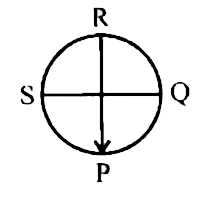Take a piece of thread and tie a small piece of stone at one of its ends. Move the stone to describe a circular path with constant speed by holding the thread at the other end.

Now let the stone go by releasing the thread Can you tell the direction in which the stone moves after it is released ? By repeating the activity for a few times and releasing the stone at different positions of the circular path, check whether the direction in which stone moves remains the same or not ?
The stone will move along a straight line tangentially to the circular path. This is because once the stone is released, it continues to move along the direction it had been moving at that instant.
The direction of motion changes at every point while the stone moves along the circular path.
Related Playlists
- BOOK - NAND LAL PUBLICATIONCHAPTER - MOTIONEXERCISE - INTEXT QUESTION21videos
MOTION
- BOOK - NAND LAL PUBLICATIONCHAPTER - MOTIONEXERCISE - EXERCISE10videos
MOTION
- BOOK - NAND LAL PUBLICATIONCHAPTER - GRAVITATIONEXERCISE - Additional Questions (Long Answer Type Questions)1videos
GRAVITATION
- BOOK - NAND LAL PUBLICATIONCHAPTER - SOUNDEXERCISE - Additional Question (Long Answer Type Questions)2videos
SOUND
Knowledge Check
- Question 1 - Select One
A stone of mass ied to a string of lengh l rotating along & a circular path with constant speed v. The torque on the stone is
Amv2lBmvlCmvlDzero - Question 1 - Select One
A stone is released from an elevator going up with an acceleration a. The acceleration of the stone after the release is
Aa upwardBg downwardC(g−a) downwardD(g+a) downward - Question 1 - Select One
A stone of mass m is tied to a string of length l and rotated in a circle with a constant speed v . If the string is released, the stone flies
ARadially outwardBRadialy inwardCTangentially outwardDWith acceleration mv2l
Similar Questions
Take a small stone. Hold it in your hand. What are the forces acting on the stone ? Now release the stone. What do you observe ? What are the forces acting on the stone after you release it ?
View SolutionTake a small stone. Hold it in your hand. What are the forces acting on the stone ? Now release the stone. What do you observe ? What are the forces acting on the stone after you release it ?
View SolutionA stone tied to a string is rotated in a circle. If the string is cut, the stone flies away from the circle because
View SolutionA stone tied at the end of sring is whirled in a circle. If the string break , the stone flies away tangentially . Why ?
View SolutionA stone is released from an elevator going up with an acceleration a. The acceleration of the stone after the release is
View SolutionA stone is attached to one end of a string and rotated in a vertical circle . If the string breaks at the position of maximum tension , then it will break at
 View Solution
View SolutionTake a piece of thread. Tie a small piece of stone to one end of the thread. Hold the other end of the thread in hand and whirl it round. Note the motion of the stone. If the thread breakes suddenly, the stone files off along tangent to the circle at the instant.
Read the above passage and answer the following question:
(i) which force is whirling the stone ? who is providing this force ?
(ii) why does the stone fly off along the tangnet to the circle at that instant?
(iii) what value of life do you learn from this?View Solution

